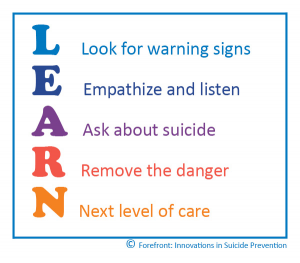

Suicide prevention efforts ripple across UW campus
Mary Giles works in the west campus area of UW Seattle, noted for its heavily trafficked pedestrian thoroughfares such as The Ave and Northeast 45th Street. Every day she sees students walking around, “utterly absorbed in their electronic devices and showing no particular need to interact with a passerby like me.” Learning that the UW has lost 20 students to suicide since the fall of 2009 was a revelation to Giles, a UW staff member, as was the fact that 1 in 4 college students have a diagnosable mental illness. On the UW campus, that adds up to nearly 11,000 students. Giles saw students in a new light, suggesting that “these tech-savvy, fast-moving youth are at least as vulnerable as we students were 40 years ago.”

Giles recently attended a Forefront suicide-prevention training program that is available cost-free to UW students, staff and faculty. The program uses the LEARN model (please see infographic), developed by Lauren Davis, Forefront Director of Campuses and Schools. In a letter to Forefront director Matt Taylor, Giles praised the program’s “empowering and immediately usable skills,” adding that it also “changes the wavelength of our awareness and discourse. With a talk of this nature, there is just no telling how far the ripples will go.”
The ripples have already reached the highest echelons of the university. In a Feb. 16 message to colleagues, UW President Ana Mari Cauce praised Forefront and its co-founder, Jennifer Stuber, associate professor in the School of Social Work, for creating “a remarkable coalition to prevent suicide.” Using research on the leading means of suicide—firearms and medications—“Forefront enlisted gun rights advocates and pharmacists to create a bill that establishes incentives for gun stores and pharmacies to provide suicide prevention training to employees,” Cauce wrote. “… (T)his measure will undoubtedly save lives.”
In addition, UW Interim Provost Gerald J. Baldasty recently sent a letter about suicide prevention to all UW students, staff and faculty. He noted that “mental health and substance abuse are among the most cited reasons college students don’t complete their degrees.” Baldasty offered statistics, resources and advice that is relevant to any workplace, home or other community:
- Ask your colleagues and classmates how they’re doing. Ask sincerely. Really listen.
- Learn the warning signs of suicide.
- Save the National Suicide Prevention Lifeline number in your phone (800-273-8255)
- Share that number with at least three colleagues, friends or family members.
- Get involved with organizations dedicated to suicide prevention and/or awareness of mental health and mental illness, and participate in their events.
Husky Help and Hope Walk
This year’s Husky Help and Hope (H3) Walk on Saturday, April 30, called on students and community supporters to “Walk, Talk, Break the Stigma.” It began with inspiring speeches and bonding at Intellectual House followed by 2-mile walk through the sun-drenched UW campus to commemorate those lost to suicide, and support survivors and loss survivors. Walkers paused halfway through at Rainier Vista at Forefront’s memorial installation representing the 1,111 Washingtonians lost to suicide in 2014.
The response exceeded the organizer’s high aspirations, bringing out 707 walkers and raising $8440. Donations are still welcome and proceeds will go toward developing suicide-prevention resource tool kits that will be distributed around campus for students, faculty and staff, according to Micia Vergara, president of the campus club Huskies for Suicide Prevention and Awareness (HSPA). For example, “If a faculty member knows a student is in crisis or struggling with depression, they could suggest the student take the resource packet home and give it a try,” Vergara said.
Vergara’s involvement with HSPA grew from an interest in campus clubs. Freshman year, she says she got involved in lots of different things but found her interest in most of them waned quickly. The next year she sought out areas “that really resonated. … I’m interested in mental health; it’s really personal for me and my friends, so I tried it out. I fell in love with HSPA from the get-go—it’s such a supportive group!” The work also dovetails well with Vergara’s public health major.
More about LEARN
The LEARN curriculum model was developed last year as Forefront’s training mission expanded. “We realized that Forefront needed its own curriculum. This one gives more attention to the ‘removing the danger’ step so essential to suicide prevention,” said Davis. ”This includes integrating information on safe storage of lethal means and on how to work on removing dangers when a person is at risk.” The new model was first rolled out last September for the Forefront in the Schools program, which is being implemented this school year in 14 high schools in the Puget Sound region.
The LEARN training is presented in a slide-show format; each letter of the word stands for a concept (see the infographic above) that is further elaborated upon. The slides are augmented by small-group discussions, interactive elements and role-playing in the training sessions, Davis said. The model is also being used at the University of Washington in free, 90-minute training sessions for faculty, staff and students.
The UW sessions provide relevant resources and on-campus referral procedures. “How do you access them, what to expect when you access them,” Davis said. Most UW sessions are being offered at the departmental level. “The response has been very positive,” she added. — By Karen Rathe